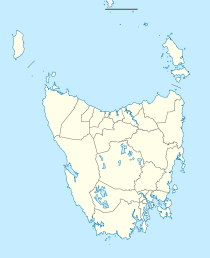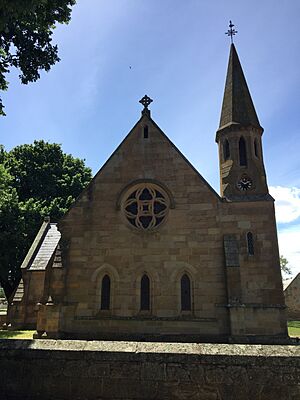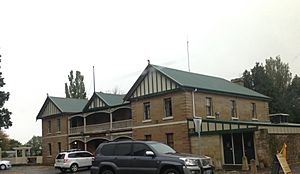Ross, Tasmania facts for kids
Quick facts for kids RossTasmania |
|||||||||
|---|---|---|---|---|---|---|---|---|---|
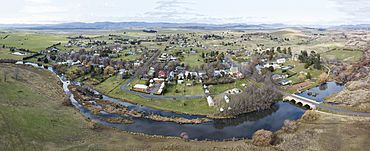
Aerial panorama of Ross
|
|||||||||
| Population | 404 (2016 census) | ||||||||
| Established | 1812 | ||||||||
| Postcode(s) | 7209 | ||||||||
| Elevation | 186 m (610 ft) | ||||||||
| Location |
|
||||||||
| LGA(s) | Northern Midlands Council | ||||||||
| State electorate(s) | Lyons | ||||||||
| Federal Division(s) | Lyons | ||||||||
|
|||||||||
Ross is a small village in the middle of Tasmania, a state in Australia. It sits by the Macquarie River. Ross is about 78 kilometers south of Launceston and 117 kilometers north of Hobart. The village is famous for its old bridge, beautiful sandstone buildings, and its history linked to convicts. It's even listed as a special heritage place!
Contents
Ross's Story
The land where Ross is now was first home to the Aboriginal Tasmanians, especially the Tyrernotepanner (Stony Creek) Nation. They called this area Makala.
The first European to explore this region was a surveyor named Charles Grimes. He mapped central Tasmania, including parts of the Macquarie River.
In 1821, Governor Lachlan Macquarie visited the area. He wrote in his journal that he named the spot "Ross." He did this to honor H. M. Buchanan, whose home in Scotland was also called Ross. Governor Macquarie thought this part of the Macquarie River was very beautiful.
Later that year, a wooden bridge was built over the river. This made Ross an important stop for travelers going between Launceston and Hobart. Soon, cattle were raised here for work and milk. Ross grew into a base for soldiers and a trading center for the area. Between 1848 and 1854, about 12,000 women convicts passed through the Female Factory.
The Ross Post Office opened on June 1, 1832. The famous stone bridge, known as Ross Bridge, was finished in 1836.
By 1901, when Australia became a federation, Ross had 311 people living there. The area was well-known for growing fine wool. At that time, Ross had four churches, a post office, a bank, one hotel, and a town hall with a library.
Ross's Weather
| Climate data for Ross (1991–2020 normals, extremes 1993–present) | |||||||||||||
|---|---|---|---|---|---|---|---|---|---|---|---|---|---|
| Month | Jan | Feb | Mar | Apr | May | Jun | Jul | Aug | Sep | Oct | Nov | Dec | Year |
| Record high °C (°F) | 41.6 (106.9) |
36.6 (97.9) |
35.3 (95.5) |
28.9 (84.0) |
22.5 (72.5) |
18.7 (65.7) |
17.6 (63.7) |
19.6 (67.3) |
23.2 (73.8) |
29.2 (84.6) |
33.1 (91.6) |
37.8 (100.0) |
41.6 (106.9) |
| Mean daily maximum °C (°F) | 24.8 (76.6) |
24.0 (75.2) |
21.8 (71.2) |
17.6 (63.7) |
14.3 (57.7) |
11.7 (53.1) |
11.3 (52.3) |
12.5 (54.5) |
14.6 (58.3) |
17.2 (63.0) |
20.1 (68.2) |
22.8 (73.0) |
17.7 (63.9) |
| Daily mean °C (°F) | 17.8 (64.0) |
17.3 (63.1) |
15.0 (59.0) |
11.6 (52.9) |
8.8 (47.8) |
6.7 (44.1) |
6.4 (43.5) |
7.3 (45.1) |
9.1 (48.4) |
11.1 (52.0) |
13.6 (56.5) |
15.8 (60.4) |
11.7 (53.1) |
| Mean daily minimum °C (°F) | 10.7 (51.3) |
10.6 (51.1) |
8.2 (46.8) |
5.6 (42.1) |
3.4 (38.1) |
1.7 (35.1) |
1.4 (34.5) |
2.1 (35.8) |
3.6 (38.5) |
5.0 (41.0) |
7.0 (44.6) |
8.8 (47.8) |
5.7 (42.3) |
| Record low °C (°F) | −0.4 (31.3) |
−0.2 (31.6) |
−3.3 (26.1) |
−5.6 (21.9) |
−6.9 (19.6) |
−7.0 (19.4) |
−7.6 (18.3) |
−6.3 (20.7) |
−6.4 (20.5) |
−5.6 (21.9) |
−3.2 (26.2) |
−2.5 (27.5) |
−7.6 (18.3) |
| Average precipitation mm (inches) | 43.9 (1.73) |
36.2 (1.43) |
37.4 (1.47) |
36.7 (1.44) |
33.1 (1.30) |
39.8 (1.57) |
41.1 (1.62) |
46.7 (1.84) |
49.7 (1.96) |
43.4 (1.71) |
44.9 (1.77) |
39.3 (1.55) |
492.3 (19.38) |
| Average precipitation days (≥ 1 mm) | 4.7 | 5.1 | 5.4 | 6.3 | 6.5 | 7.3 | 8.4 | 8.4 | 9.1 | 8.3 | 6.8 | 6.2 | 82.4 |
| Average dew point °C (°F) | 8.7 (47.7) |
9.6 (49.3) |
8.3 (46.9) |
7.0 (44.6) |
5.6 (42.1) |
4.3 (39.7) |
3.9 (39.0) |
3.9 (39.0) |
4.9 (40.8) |
5.8 (42.4) |
7.0 (44.6) |
7.3 (45.1) |
6.4 (43.5) |
| Source 1: National Oceanic and Atmospheric Administration | |||||||||||||
| Source 2: Bureau of Meteorology | |||||||||||||
The Four Corners of Ross
The center of Ross is where Church Street and Bridge Street meet. Here, you'll find a field gun from the Boer War and a war memorial. This intersection is playfully called the "Four Corners of Ross." Each corner has a special nickname:
- Temptation: This is where the Man O' Ross Hotel is located.
- Recreation: This corner has the Old Town Hall.
- Salvation: Here you'll find the Roman Catholic Church.
- Damnation: This used to be the Jail, but now it's a private home.
Historic Buildings and Places
The whole village of Ross is a special heritage site. Many of its old buildings, often made from local sandstone, are also listed as important historical places.
Old Military and Police Buildings

The old Army Orderly Room is a stone building from the Colonial era. It was the first army headquarters in Ross. Nearby is the Royal Ordnance Corps Store, built in 1836. It has the army corps' symbol carved above its door. In 1951, this building became the Ross War Memorial Building. It was made bigger to include the Ross Memorial Library and a recreation room for soldiers from World War Two.
The Council Clerk's cottage is a single-story building in the Georgian style. Its western part used to be the police station. There was also a jail on this spot.
Close to the Ross Bridge, you can see the old military barracks. This single-story Colonial building has been recently fixed up.
Convict Site
The convict site dates back to the 1840s. It's usually called the Female Factory. This was one of the few places in Australia built specifically for women convicts. Today, only one building remains, the Assistant Superintendent's Quarters. It now has a display that tells the story of the site.
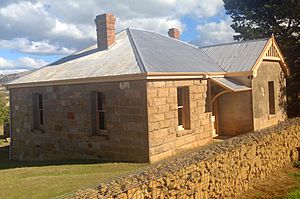
Churches
Ross has three churches, all on Church Street, which is lined with elm trees. The Uniting Church sits high on a hilltop. Built in 1885, it's known for its blackwood pews and carved baptismal font. The Roman Catholic Church building was once a store. It was changed into a church in the 1920s in the Gothic revival style. St John's Anglican Church, built in 1868, has a 100-year-old pipe organ, an oak lectern, and a stone pulpit.
Hotels and Inns
The Man O' Ross Hotel was built in 1831. It started as a two-story Georgian building but was later updated to a Victorian style. Two other old inns, The Scotch Thistle Inn and the Sherwood Castle Inn, are no longer hotels. The Scotch Thistle Inn is now a private home, and the Sherwood Castle Inn has been renamed the Ross Bakery Inn.
Ross Bridge
The famous sandstone Ross Bridge was built by convict workers in 1836. It is the third oldest bridge still used in Australia! Lieutenant-Governor Arthur ordered its construction. The bridge was designed by architect John Lee Archer. The convict team included two skilled stonemasons, James Colbeck and Daniel Herbert. Daniel Herbert is known for the amazing carvings you can see along both sides of the bridge.
Cemeteries
The main cemetery is southeast of the town center. It has two parts: a Roman Catholic section and a Church of England section, which is surrounded by a stone wall. An old military burial ground is on a nearby hilltop.
Other Public Buildings
The Town Hall is a grand building in a Victorian style. The Council Chambers next to it are made of timber with a stone front. The Post Office, finished in 1889, has a porch with two cast-iron columns. The schoolhouse is a Victorian Rustic Gothic building with walls made of rough sandstone.
Other Special Places
In the center of Ross, there are other important buildings, including private homes and two former Sunday Schools, which are also listed as heritage sites. Also, some special Indigenous sites are located nearby.
The old Horton College (1855–1894) near Ross is now in ruins, but its remains are also listed as a heritage site.
Things to Do in Ross
The Tasmanian Wool Centre is a building that has a museum, a wool exhibition, and a craft area. It also works as the main tourist information centre for visitors.
Tooms Lake was created as a dam to supply water to Ross.
The Ross Village Bakery: A Sweet Connection
The Ross Village Bakery has become very popular with anime fans. Many believe it was the real bakery that inspired the one in the 1989 Studio Ghibli animated movie Kiki's Delivery Service. An attic room above the bakery has even been made to look like the main character's bedroom!
Fans of the movie, especially from Japan, visit the bakery like it's a special journey. The bakery staff let visitors see the old oven and the recreated bedroom.
This bakery is the original one for Ross. It was built in 1860 and still uses its original wood-fired oven.
Images for kids


